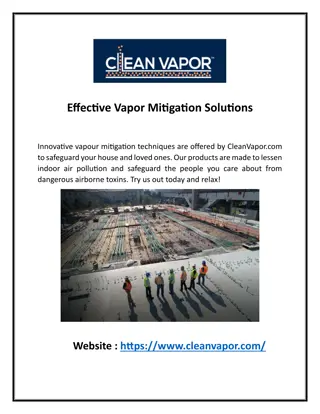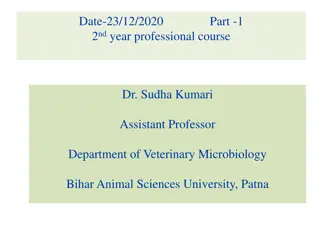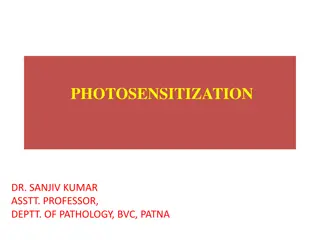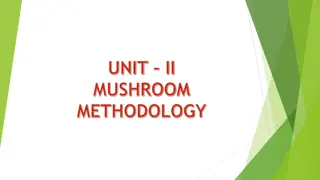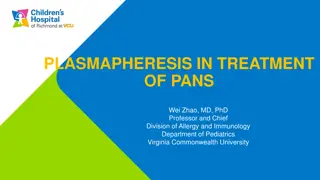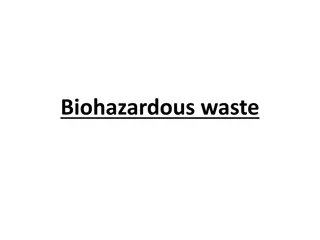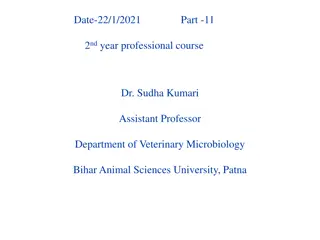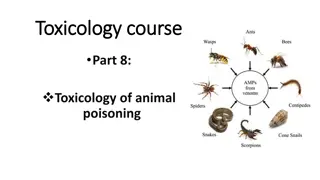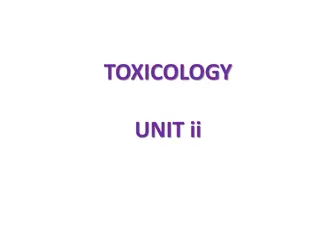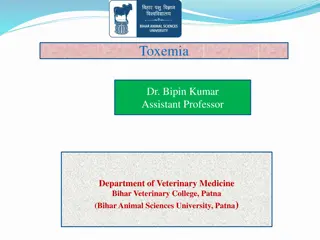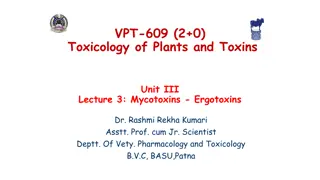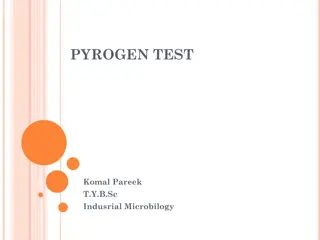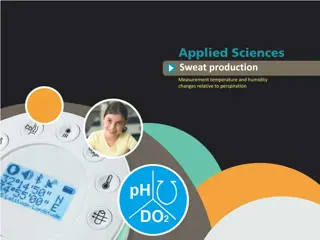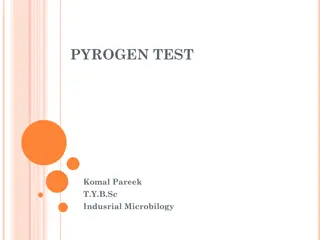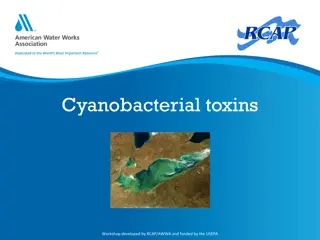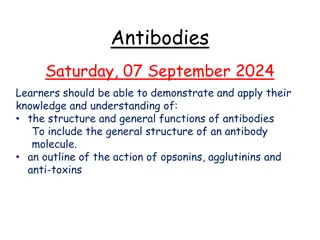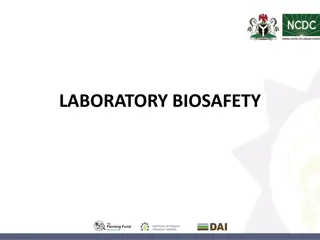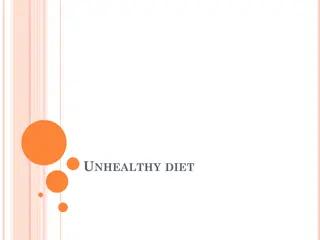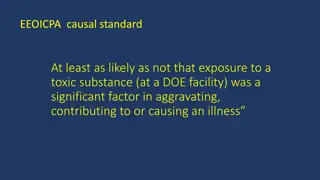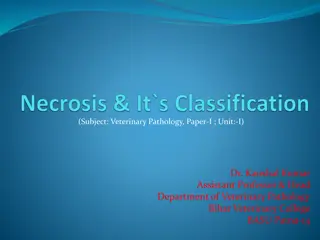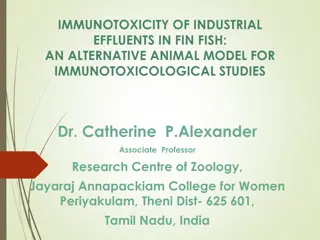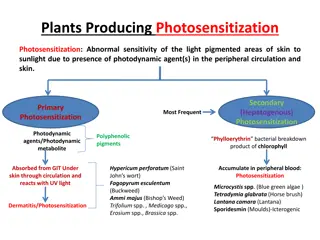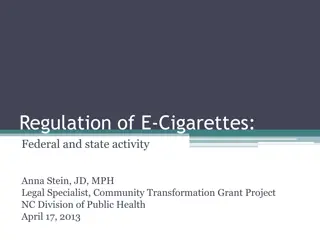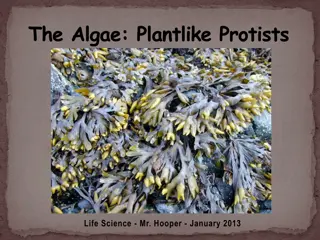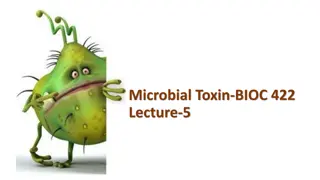DERMATOLOGY AND RHEUMATOLOGY
Staphylococcal Scalded Skin Syndrome (SSSS) is a serious condition characterized by red blistering skin resembling burns. It is caused by toxins from Staphylococcus aureus, leading to exfoliation of the skin. Common in infants, the elderly, and immunocompromised individuals, SSSS requires prompt dia
0 views • 89 slides
Understanding Neurogenic Speech and Language Disorders in Adults
This chapter provides insight into language disorders in adults, including types of aphasia, causes such as toxins, traumatic brain injury, brain tumors, and strokes. It discusses cerebral hemorrhage, occlusive strokes, ischemic stroke, transient ischemic attacks, and cerebral thrombosis. The conten
1 views • 34 slides
Understanding the Positive and Negative Aspects of Fishes
Dr. Mohammad Hamed Bahnasawy, a Professor of fish biology, discusses the positive aspects like diversity and importance of fishes, alongside the negative aspects such as poisonous and venomous fishes, highlighting toxins present in different fish species and risks associated with consumption.
2 views • 28 slides
FUNGAL SPECIES AND THEIR TOXINS.
Explore the world of fungal species and their toxins as studied by Prof. Abdullah Msaad Al-Falih at King Saud University's College of Science. Discover over 500 mycotoxins, including aflatoxins, ochratoxins, trichothecenes, fumonisins, sterigmatocystin, ergot alkaloids, zearalenone, Alternaria toxin
2 views • 8 slides
Biological Registration Process and Administrative Controls for Safety Focus
Registering work involving biological materials, toxins, and recombinant DNA is essential for safety compliance. Principal Investigators must follow NIH guidelines and register with the Institutional Biosafety Committee. Contact NIH for additional instructions on working with toxins and Select Agent
4 views • 13 slides
Understanding Bacterial Toxins and Cell Damage
Bacterial toxins are poisonous substances produced by microbes that can cause harm to host cells through direct damage, toxin production, and hypersensitivity reactions. Toxigenesis is a crucial mechanism used by bacterial pathogens to induce disease, with endotoxins and exotoxins playing distinct r
2 views • 28 slides
Understanding Kidney Failure: Causes, Symptoms, and Treatment Options
Kidney failure can be temporary or chronic, affecting the body's ability to eliminate toxins. Common causes include diabetes and high blood pressure. Recognizing symptoms early and managing conditions like diabetes can prevent kidney failure. Treatment options such as dialysis and kidney transplant
7 views • 47 slides
Effective Vapor Mitigation Solutions
Innovative vapour mitigation techniques are offered by CleanVapor.com to safeguard your house and loved ones. Our products are made to lessen indoor air pollution and safeguard the people you care about from dangerous airborne toxins. Try us out today and relax!\n\n\/\/ \/
4 views • 1 slides
Why fire resistant ply is a need of the hour today
The emergence and importance of fire retardant plywood in construction and carpentry cannot be overstated. In a world where safety and sustainability are paramount concerns, fire-resistant plywood stands as a crucial innovation. Its ability to slow down the progression of fires, enhance safety durin
1 views • 5 slides
Panchakarma Treatment Detoxify and Rebalance
This article introduces Panchakarma, an ancient Ayurvedic detox ritual for cleansing and rebalancing the body. It suggests considering Panchakarma treatment if feeling worn out or out of sync. The process involves five therapies, including vomiting, purgation, and enemas, to eliminate toxins and res
2 views • 5 slides
Understanding Clostridium Tetani: Characteristics and Habitats
Clostridium tetani is an obligate anaerobe that forms terminal spores giving it a drumstick-like appearance. It is heat-sensitive, non-motile, and can produce toxins. Spores are found in soil and the gastrointestinal tracts of various animals. The bacterium can also be present on human skin and in c
0 views • 23 slides
Exploring the Benefits and Techniques of Lymphatic Drainage Massage | healthcare
Lymphatic drainage massage is a therapeutic technique aimed at improving the flow of lymph, a fluid that carries waste and toxins away from tissues back toward the heart.
0 views • 4 slides
Understanding Photosensitization in Animals - Causes and Types
Photosensitization in animals is the activation of photodynamic chemicals on the skin by UV or visible light, leading to cellular damage and inflammation. Factors necessary for photosensitization include oxygen, sunlight, specific chemicals, and skin lacking pigments. Types of photosensitization inc
1 views • 8 slides
Understanding Mushroom Types and Characteristics
Mushrooms, consumed as energy-rich food, come in various types like poisonous and common edible mushrooms. Poisonous mushrooms contain toxins that can be harmful, while edible mushrooms offer a variety of nutritious options. Learn about the features and symptoms associated with poisonous mushrooms a
2 views • 19 slides
Plasma Exchange in Treatment of PANS - Overview and Considerations
Plasmapheresis, a type of apheresis, plays a crucial role in managing Pediatric Acute-onset Neuropsychiatric Syndrome (PANS) and Pediatric Autoimmune Neuropsychiatric Disorders Associated with Streptococcal Infections (PANDAS). This treatment involves separating the extracellular component of blood
0 views • 26 slides
Understanding Biohazardous Waste Management
Biohazardous waste poses a threat to living organisms, particularly humans, due to biological hazards like medical waste or toxins. This waste includes categories such as solid, liquid, sharps, and pathological waste, each requiring proper segregation and disposal to minimize health risks. Learn abo
0 views • 15 slides
RMT Massage in Sheppard: Expert Care and Revitalized Health
RMT Massage in Sheppard provides expert care and revitalizes health for improved well-being. At our Health Care Center in Toronto, our therapists concentrate on pressure points to remove toxins from the body and balance your body and mind. We blend a
1 views • 6 slides
Understanding Clostridium perfringens: Morphology, Cultural Characteristics, Toxins, and Diseases
Clostridium perfringens is a Gram-positive spore-forming bacillus found in various environments. It exhibits distinct morphological characteristics, cultural behaviors, and produces different toxins associated with diseases in humans and animals. Understanding its properties is crucial for effective
1 views • 26 slides
Understanding Animal Venom and Snake Classification in Toxicology
Animal venom, particularly snake venom, contains various toxins that can have detrimental effects on the body. Different types of snake venom target specific systems, such as neurotoxic venom affecting neuromuscular junctions and hemotoxic venom impacting the cardiovascular system. Understanding the
4 views • 27 slides
Overview of Toxicology: Understanding Chemical Risks and Health Impacts
Toxicology is a crucial field that assesses the effects of various toxic substances on human health and the environment. From heavy metals to solvents, radiation, pesticides, and animal toxins, this discipline plays a vital role in identifying and managing risks associated with exposure to harmful c
0 views • 25 slides
Overview of Bladder Tumours: Causes, Symptoms, and Diagnosis
Bladder tumours, particularly Transitional Cell Carcinoma (TCC), are the second most common cancer in the genitourinary system. Mainly caused by factors like cigarette smoking, industrial toxins, and genetic events, bladder cancer presents with symptoms such as hematuria and irritative voiding sympt
0 views • 26 slides
Understanding Toxemia in Veterinary Medicine
Toxemia is a systemic condition triggered by toxins from bacteria or tissue injury, not plant or insect toxins. Endotoxemia, caused by LPS cell components of Gram-negative bacteria, leads to severe physiological abnormalities. Etiology involves various toxin types, including exotoxins and enterotoxi
1 views • 15 slides
Understanding Ergot Alkaloids: Toxicology of Plants and Toxins
Ergot alkaloids are toxins produced by parasitic fungi that invade cereal crops and grasses, leading to the formation of ergot. These toxins, including ergometrine and ergotamine, have various effects on the central nervous system, smooth muscles, and overall health. Ergotism, resulting from the ing
0 views • 14 slides
Understanding Pyrogen Testing in Pharmaceutical Manufacturing
Pyrogen testing plays a crucial role in ensuring the safety of vaccines and drugs by detecting the presence of bacterial toxins that may cause fever in humans. The process involves various methods such as rabbit pyrogen testing and human response evaluation to safeguard against pyrogen contamination
2 views • 8 slides
Understanding Sweat Production and Temperature Regulation
Explore the relationship between sweat production, skin temperature, and environmental humidity in maintaining our body's cooling system. Discover the physiological significance of perspiration in thermoregulation and its role in eliminating toxins. Engage in an experiment to investigate how the bod
4 views • 23 slides
Understanding Pyrogen Testing in Pharmaceutical Production
Pyrogen testing is crucial in ensuring pharmaceutical safety by detecting bacterial toxins that may cause fever in humans. Methods such as the rabbit pyrogen test and human response to pyrogens illustrate the importance of quality control measures in production to prevent contamination. By identifyi
0 views • 8 slides
Understanding Cyanobacterial Toxins Workshop
Explore the comprehensive workshop developed by RCAP/AWWA and funded by the USEPA on cyanobacterial toxins. Learn about the basics of cyanobacteria toxins, understanding when and why they occur, taking necessary actions, and limiting exposure. Delve into topics such as terminology, harmful algal blo
0 views • 49 slides
Understanding Poisonous Plants and Their Effects on Humans
Poisonous plants can have deleterious effects on individuals, leading to severe consequences and even death if not managed properly. These plants produce toxins that interfere with the body's essential functions, ultimately causing impairment and potential fatality. Recognizing the grades of poisoni
0 views • 11 slides
Understanding Antibodies: Structure, Functions, and Applications
Explore the structure and functions of antibodies, including how they bind to antigens, act as opsonins, agglutinins, and anti-toxins. Learn about the specificity of antibodies, their variable regions, and their role in neutralizing pathogens and viruses. Gain insights into how antibodies help the i
1 views • 17 slides
Understanding Biosafety and Containment Measures in Laboratories
This content provides comprehensive information on biosafety, containment, biohazards, and the importance of preventing laboratory acquired infections. It covers the principles, practices, and procedures designed to safeguard against biological agents and toxins. The concept of biosecurity, containm
3 views • 17 slides
Understanding the Connection Between Oral Health and Systemic Diseases
The relationship between oral health and systemic diseases is significant, with manifestations within the oral cavity providing clues to underlying systemic issues. Disease processes involve aspects like etiology, pathogenesis, morphologic changes, and clinical significance. Organisms and toxins spr
0 views • 19 slides
Understanding Food Poisoning and Its Causes
Food poisoning is a common threat that can be prevented with proper food handling. It is caused by various microorganisms, natural toxins, and chemical residues. The illness is characterized by rapid onset of symptoms like vomiting and diarrhea. Common bacteria causing food poisoning include Staphyl
0 views • 27 slides
Understanding Causal Factors in Illness: Toxins, Smoking, and Contributing Causes
Causal standards for illness attribution, toxins' role in disease onset and expression, and the impact of factors like smoking and contributing causes on health outcomes are explored. The distinction between certain and contributing causes, as well as the level of certainty in carcinogen classificat
1 views • 19 slides
Understanding Necrosis: Causes, Characteristics, and Differences from Autolysis
Necrosis is the death of cells and tissues in living animals, characterized by various causes such as poisons, toxins, circulatory disturbances, and mechanical injuries. It presents gross appearances like white, gray, or yellow areas with a cooked meat appearance and distinct demarcation from health
0 views • 18 slides
Understanding Immunotoxicity in Fish: An Alternative Model for Toxicological Studies
The study explores the immunotoxic effects of industrial effluents on fin fish, highlighting xenobiotics' impact on the immune system. It discusses the sensitivity of the immune system to environmental toxins and the elicitation of immune reactions by various substances. The importance of fish as a
0 views • 25 slides
Understanding Photosensitization in Plants: Causes and Toxicity
Photosensitization in plants can lead to abnormal skin sensitivity to sunlight, caused by the presence of photodynamic agents in the skin and peripheral circulation. Primary and secondary photosensitization are common, with various plants and toxins contributing to liver damage and biliary occlusion
0 views • 12 slides
Regulation of E-Cigarettes: Federal and State Activity Overview
This presentation discusses the regulation of e-cigarettes at the federal and state levels, how e-cigarettes work, ingredients inhaled by users, findings from FDA studies, and research on the emissions of carcinogens and toxins from e-cigarette vapor. The content highlights concerns about the lack o
0 views • 24 slides
The Fascinating World of Algae and Protists
Algae, diatoms, dinoflagellates, euglenoids, and red algae are diverse plant-like protists crucial for Earth's ecosystems. They range from unicellular to multicellular forms, contributing significantly to oxygen production and food chains. While some like red algae thrive in deep ocean waters, other
0 views • 20 slides
Understanding Coevolution: An Example from Wild Parsnip and Webworms
Coevolution, a reciprocal evolutionary change in interacting species, can be observed in the relationship between wild parsnip plants containing toxic compounds and webworms that can metabolize these toxins. This example demonstrates the prerequisites for coevolution, including genetic variation and
0 views • 35 slides
Understanding Bacterial Toxins: Production, Types, and Effects
Explore the world of bacterial toxins, focusing on production mechanisms, various types such as cytotoxins and their effects on host cells. Delve into specific examples like Diphtheria Toxin caused by Corynebacterium diphtheriae, understanding its biological features and the disease it leads to.
0 views • 13 slides







